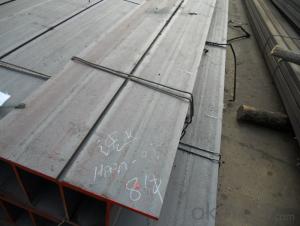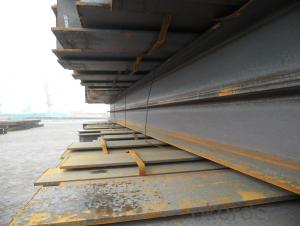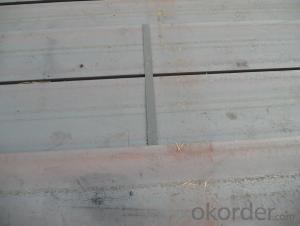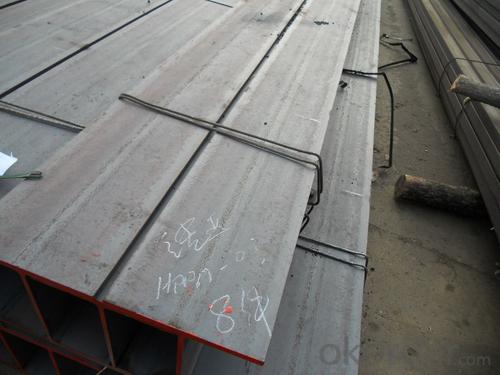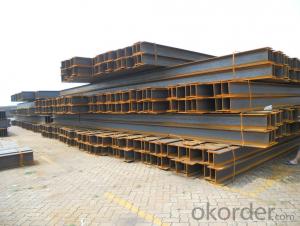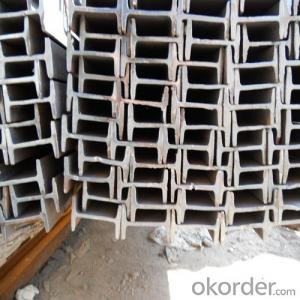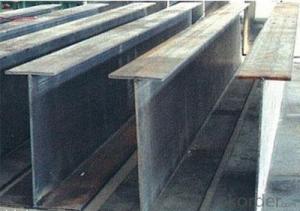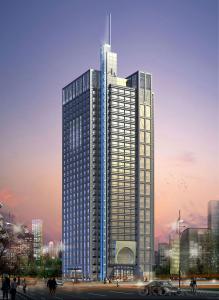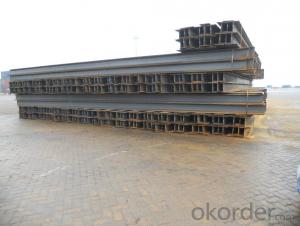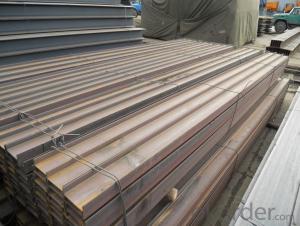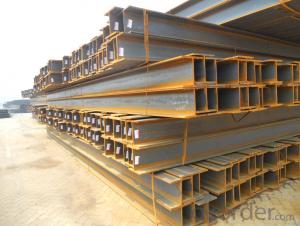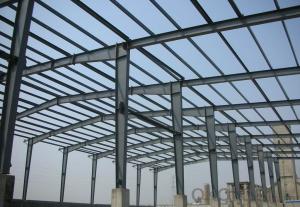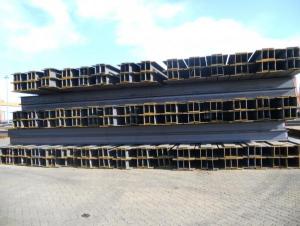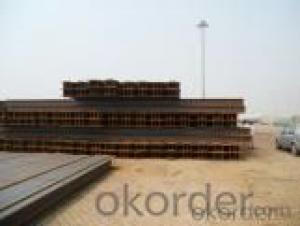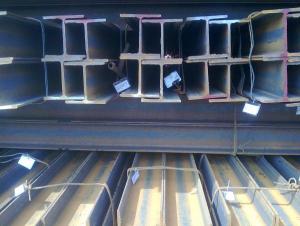Hot Rolled Steel H-Beam for Prefabrication structure
- Loading Port:
- Tianjin
- Payment Terms:
- TT OR LC
- Min Order Qty:
- 150000 m.t.
- Supply Capability:
- 350000 m.t./month
OKorder Service Pledge
OKorder Financial Service
You Might Also Like
Specification
Product Description:
Product Description:
OKorder is offering Hot Rolled Steel H-Beam for Prefabrication structure at great prices with worldwide shipping. Our supplier is a world-class manufacturer of steel, with our products utilized the world over. OKorder annually supplies products to European, North American and Asian markets. We provide quotations within 24 hours of receiving an inquiry and guarantee competitive prices.
Product Applications:
Hot Rolled Steel H-Beam for Prefabrication structure are ideal for structural applications and are widely used in the construction of buildings and bridges, and the manufacturing, petrochemical, and transportation industries.
Product Advantages:
OKorder's Hot Rolled Steel H-Beam for Prefabrication structure are durable, strong, and resist corrosion.
Main Product Features:
· Premium quality
· Prompt delivery & seaworthy packing (30 days after receiving deposit)
· Corrosion resistance
· Can be recycled and reused
· Mill test certification
· Professional Service
· Competitive pricing
Product Specifications:
Specifications of Hot Rolled Steel H-Beam for Prefabrication structure
1. Standard: GB700-88, Q235B2.
2. Grade: Q235, SS400 or Equivalent
3. Length:10m, 12m as following table
4. Invoicing on theoretical weight or actual weight as customer request
5.Payment: TT or L/C
6. Sizes:
SIZE(mm) | DIMENSION(kg/m) |
150*75 | 14 |
150*150 | 31.1 |
148*100 | 20.7 |
198*99 | 17.8 |
200*100 | 20.9 |
248*124 | 25.1 |
250*125 | 29 |
Usage & Applications of Hot Rolled Steel H-Beam for Structure Steel
Commercial building structure ;Pre-engineered buildings; Machinery support structure; Prefabricated structure; Medium scale bridges; Ship-building structure. etc.
Packaging & Delivery of Hot Rolled Steel H-Beam for Prefabrication structure
1. Packing: it is nude packed in bundles by steel wire rod
2. Bundle weight: not more than 3.5MT for bulk vessel; less than 3 MT for container load
3. Marks:
Color marking: There will be color marking on both end of the bundle for the cargo delivered by bulk vessel. That makes it easily to distinguish at the destination port.
Tag mark: there will be tag mark tied up on the bundles. The information usually including supplier logo and name, product name, made in China, shipping marks and other information request by the customer.
If loading by container the marking is not needed, but we will prepare it as customer request.
4. Transportation: the goods are delivered by truck from mill to loading port, the maximum quantity can be loaded is around 40MTs by each truck. If the order quantity cannot reach the full truck loaded, the transportation cost per ton will be little higher than full load.
5. Delivered by container or bulk vessel
Production flow of Hot Rolled Steel H-Beam for Prefabrication structure
Material prepare (billet) —heat up—rough rolling—precision rolling—cooling—packing—storage and transportation
FAQ:
Q1: Why buy Materials & Equipment from OKorder.com?
A1: All products offered byOKorder.com are carefully selected from China's most reliable manufacturing enterprises. Through its ISO certifications, OKorder.com adheres to the highest standards and a commitment to supply chain safety and customer satisfaction.
Q2: How do we guarantee the quality of our products?
A2: We have established an advanced quality management system which conducts strict quality tests at every step, from raw materials to the final product. At the same time, we provide extensive follow-up service assurances as required.
Images:
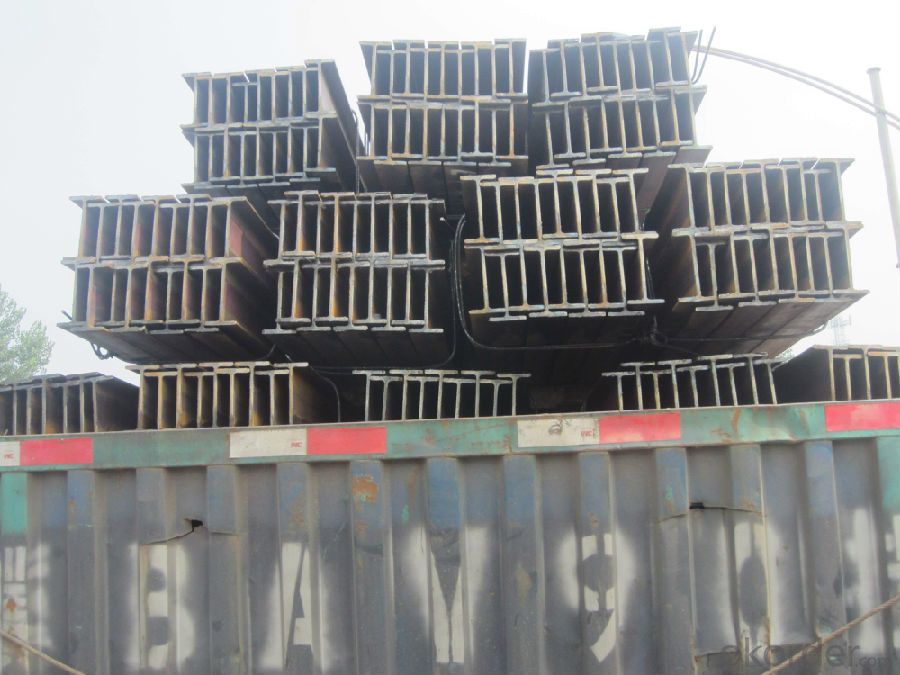
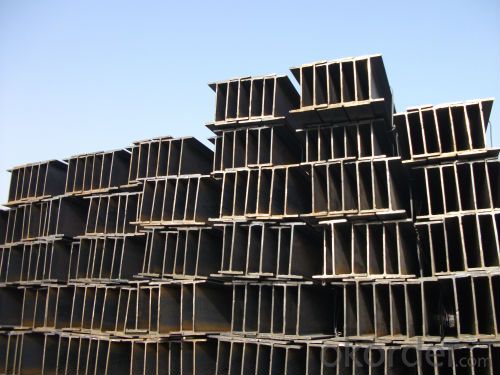
- Q: What are the common design considerations for steel H-beams in roofing applications?
- Some common design considerations for steel H-beams in roofing applications include the beam's load-carrying capacity, span length, deflection limits, and overall structural stability. Additionally, factors such as the weight of the roofing material, wind loads, and potential snow accumulation need to be taken into account. The design should also consider the potential for thermal expansion and contraction, as well as the need for proper drainage to prevent water accumulation.
- Q: How do steel H-beams withstand extreme weather conditions?
- Steel H-beams are constructed using high-quality steel alloys, like carbon steel or stainless steel, to ensure their ability to endure severe weather conditions. Their inherent strength and durability enable them to withstand extreme weather elements. To begin with, steel H-beams possess exceptional tensile strength, enabling them to resist heavy loads and external forces. This strength allows them to endure strong winds, heavy snow loads, and even earthquakes. Furthermore, their unique H-shape design enhances stability and structural integrity, making them less prone to bending or buckling during extreme weather. Additionally, steel H-beams often undergo coating or galvanization processes to safeguard against corrosion and rust caused by atmospheric moisture or chemicals. This protective layer acts as a barrier, preventing water and other damaging substances from penetrating the steel surface. By enhancing durability, this coating ensures the beams' ability to endure harsh weather conditions over an extended period. Moreover, due to steel's excellent heat conductivity, H-beams effectively dissipate heat generated by extreme temperatures. This property prevents excessive expansion or contraction, reducing the risk of structural damage. Consequently, steel H-beams can endure both extreme heat and cold, making them suitable for areas with significant temperature variations or severe weather. In conclusion, steel H-beams are designed to withstand extreme weather conditions due to their high tensile strength, stability, resistance to corrosion, and effective heat dissipation. These qualities make them a dependable choice for diverse construction projects, ensuring the integrity and safety of structures even in the most challenging weather environments.
- Q: What are the different types of connections used for steel H-beams in bridges?
- Steel H-beams in bridges can be connected in different ways to provide strength, stability, and durability. Some common types of connections are: 1. Welded Connections: The most commonly used connection involves welding the flanges and webs of the H-beams together using high-strength techniques like electric arc or submerged arc welding. These welds offer excellent strength and rigidity. 2. Bolted Connections: Another option is using high-strength bolts to connect the H-beams. Bolted connections are useful when easy disassembly or replacement is required. The H-beams have pre-drilled holes in the flanges and webs, and bolts are inserted and tightened with nuts. Bolted connections provide good strength and can be easily adjusted or replaced. 3. Riveted Connections: Riveted connections, once widely used, have been largely replaced by welded and bolted connections. This method involves inserting heated hot-rivets into pre-drilled holes in the H-beams. As they cool, the rivets contract and create a secure connection. Riveted connections offer excellent strength but require more time and labor to install. 4. Moment Connections: Moment connections are specialized connections used in situations where H-beams need to resist bending forces, such as in continuous beam bridges. These connections allow for the transfer of moments or rotational forces between the H-beams, providing additional stability. Moment connections typically combine welding and bolting methods for optimal load transfer and structural integrity. 5. Splice Connections: Splice connections are used when longer H-beams are needed for bridge construction. Multiple shorter H-beams are connected together to form a longer beam. Splice connections can be achieved through welding or bolting methods, providing continuity and strength throughout the length of the beam. It is important to consider various factors, such as bridge design, load requirements, material availability, and construction methods, when selecting the appropriate connection type for steel H-beams in bridge construction. Consulting with structural engineers and adhering to industry standards and codes is crucial to ensure the right connection type is chosen for each specific bridge project.
- Q: Are steel H-beams resistant to impact and vibration?
- Yes, steel H-beams are highly resistant to impact and vibration. The H-shape design of these beams provides great stability and strength, making them suitable for withstanding various types of external forces, including impacts and vibrations. This structural shape enables the H-beams to distribute the load evenly along the length of the beam, reducing the concentration of stress and preventing any potential damage. Additionally, steel is known for its excellent durability and toughness, which further enhances the resistance of H-beams to impact and vibration. Consequently, steel H-beams are widely used in construction, engineering, and other industries where structural stability and resistance to external forces are crucial.
- Q: Can steel H-beams be used in the construction of railway bridges?
- Yes, steel H-beams can be used in the construction of railway bridges. Steel H-beams are commonly used in bridge construction due to their high strength-to-weight ratio, which allows for longer spans and reduces the amount of material needed. They are also more resistant to corrosion, providing durability and longevity to the structure. Additionally, steel H-beams can be easily fabricated and connected, making them a cost-effective option for railway bridge construction.
- Q: What are the different types of coatings available for steel H-beams?
- Steel H-beams have several different types of coatings available, each with its own unique benefits and properties. Some commonly used coatings for steel H-beams include: 1. Galvanized Coatings: Galvanized coatings are widely used for steel H-beams. This involves applying a layer of zinc to the steel surface through hot-dip or electroplating. Galvanized coatings provide excellent corrosion resistance, making them ideal for outdoor or moisture/chemical-exposed applications. 2. Epoxy Coatings: Epoxy coatings offer great durability and chemical resistance. They are applied as a liquid and then cured to create a protective layer. Epoxy coatings provide superior protection against corrosion and abrasion, making them suitable for harsh environments like chemical plants or marine structures. 3. Powder Coatings: Powder coatings are popular for steel H-beams due to their durability and aesthetic appeal. Applied as a dry powder and cured with heat, they form a hard protective layer. Powder coatings resist chipping, scratching, and fading, making them ideal for applications where appearance matters. 4. Paint Coatings: Paint coatings are a cost-effective option for protecting steel H-beams. Depending on specific requirements, acrylic, alkyd, or epoxy-based paints can be used. Paint coatings offer good corrosion resistance and can be customized for different colors or environmental conditions. 5. Fire-resistant Coatings: Fire-resistant coatings are designed to protect against high temperatures and flames. They help prevent weakening or collapsing of steel H-beams in case of fire. Fire-resistant coatings are commonly used in buildings, bridges, or structures where fire safety is a concern. Choosing the right coating for steel H-beams depends on factors like corrosion resistance, durability, aesthetics, and fire protection requirements. Consulting with professionals or coating manufacturers can help determine the most suitable type of coating for a specific application and environment.
- Q: Are steel H-beams suitable for use in the construction of hospitality resorts or hotels?
- Yes, steel H-beams are suitable for use in the construction of hospitality resorts or hotels. Steel H-beams offer several advantages that make them the preferred choice for construction in the hospitality industry. Firstly, steel H-beams have high strength and durability, making them capable of supporting heavy loads and providing structural stability. This is crucial for large-scale construction projects such as hospitality resorts or hotels, which often require multiple floors, large open spaces, and the ability to withstand potential natural disasters like earthquakes or hurricanes. Additionally, steel H-beams are lightweight compared to other construction materials, such as concrete or timber, which makes them easier to transport and handle during the construction process. This can lead to cost savings and faster construction times, which are essential factors in completing hospitality projects on time and within budget. Moreover, steel H-beams offer design flexibility, allowing architects and engineers to create innovative and visually appealing structures. They can be used to create large, open atriums, spacious ballrooms, and other unique architectural features that are often found in hospitality resorts or hotels. Another advantage of steel H-beams is their resistance to fire, pests, and rot. This ensures the long-term durability and safety of the structure, reducing maintenance and repair costs over time. Lastly, steel H-beams are environmentally friendly as they are typically made from recycled materials and can be recycled again at the end of their life cycle. This aligns with the growing trend of sustainable and eco-friendly construction practices in the hospitality industry. In conclusion, steel H-beams are highly suitable for use in the construction of hospitality resorts or hotels due to their strength, durability, design flexibility, fire resistance, and environmental benefits. They provide a reliable and efficient solution for constructing large-scale projects in the hospitality sector, ensuring the safety, comfort, and satisfaction of guests.
- Q: Can steel H-beams be used in shopping malls and commercial complexes?
- Yes, steel H-beams can be used in shopping malls and commercial complexes. Steel H-beams are commonly used in the construction industry due to their structural stability and strength. They offer a high load-bearing capacity, which makes them suitable for supporting heavy loads in large commercial spaces. Additionally, steel H-beams provide flexibility in design and can be easily integrated with other construction materials. Their durability and resistance to fire and corrosion make them a reliable choice for long-term use in shopping malls and commercial complexes.
- Q: Can steel H-beams be used in retail store construction?
- Yes, steel H-beams can be used in retail store construction. Steel H-beams are commonly used in construction due to their strength and durability. They provide excellent structural support, making them suitable for various applications, including retail store construction. H-beams are often used for the framing of walls, floors, and roofs, ensuring stability and safety. Additionally, steel H-beams are versatile and can be easily customized and adjusted to meet specific design requirements, making them a popular choice in retail store construction projects.
- Q: What are the different grades of steel used in H-beams?
- H-beams in the manufacturing industry commonly employ different grades of steel. The selection of steel grade relies on the desired strength and durability of the H-beam, as well as the intended application. A few frequently used grades encompass A36, A572, A588, A992, and A913. A36 steel, widely utilized, boasts exceptional strength and formability. This grade is often employed in construction projects necessitating a high strength-to-weight ratio. A572 steel, another favored grade, is renowned for its remarkable strength and weldability. It finds common use in structural applications like bridges, buildings, and heavy machinery. A588 steel is categorized as a weathering grade, gradually developing a protective rust-like appearance. This characteristic proves advantageous for outdoor applications exposed to harsh weather conditions, such as bridges and buildings. A992 steel enjoys widespread usage in H-beams due to its impressive strength and mechanical properties. Industrial and commercial structures, including warehouses, factories, and high-rise buildings, often utilize this grade. A913 steel, a high-strength low-alloy (HSLA) grade, offers exceptional yield strength and toughness. It is frequently employed in high-stress applications where weight reduction and durability play vital roles, especially in bridge construction. These examples represent only a fraction of the steel grades available for H-beams. The selection of grade hinges on project-specific requirements, encompassing load-bearing capacity, environmental conditions, and overall structural design.
Send your message to us
Hot Rolled Steel H-Beam for Prefabrication structure
- Loading Port:
- Tianjin
- Payment Terms:
- TT OR LC
- Min Order Qty:
- 150000 m.t.
- Supply Capability:
- 350000 m.t./month
OKorder Service Pledge
OKorder Financial Service
Similar products
Hot products
Hot Searches
Related keywords
